|
|
File
Archaeological Museum of the Alto Vicentino – Santorso
|
Piazza Aldo Moro 23 – 36014 Santorso (VI)
– Fax 0445 649513 |
  |
|
Summary
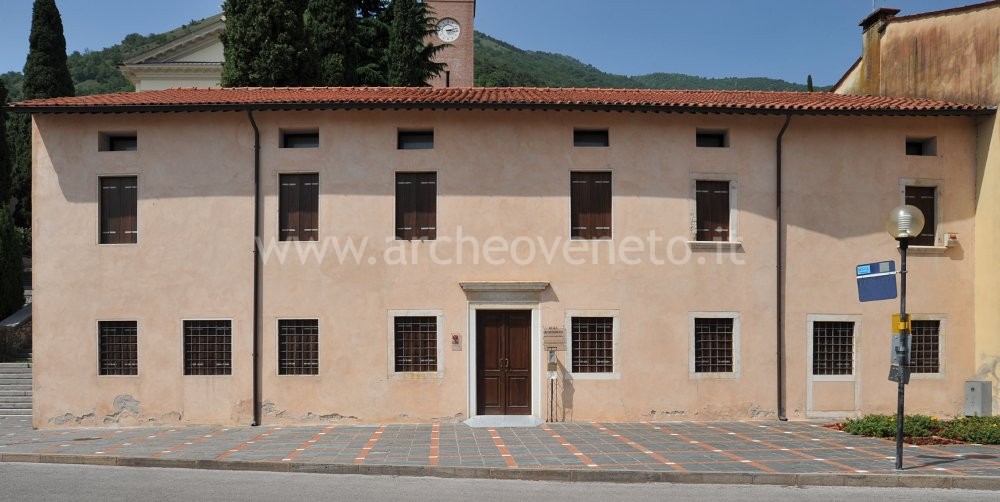
The Archaeological Museum of the Alto Vicentino displays prehistoric and proto-historic materials found in various areas of the Alto Vicentino (northern part of the Vicenza province) and the finds of a village dating back to the Iron Age discovered in Santorso. Recently another section was added, which is devoted to the late-roman necropolis of Sarcedo. The museum is organized on two floors and is characterized by a didactic and popular approach with the purpose of promoting the archaeological and environmental heritage of the Alto Vicentino. The museum is also part of the network of museums of the Alto Vicentino.
Collection history
The discoveries of the first archaeological materials (from Neolithic to the Middle Ages) took place in the early 20th century in the cave Bocca Lorenza and the site Prà Laghetto. Following these and other discoveries that were accomplished in the 70’s, the Regional Board for the Protection of the Cultural Heritage decided to commission excavation works, which have been carried out in the municipality of Santorso since 1981. These activities and the discovery of a remarkable amount of finds led to the establishment of a Didactic Archaeological Exhibition in 1986 and the Archaeological Museum of the Alto Vicentino in 1995. Both of them were created with didactic and educational purposes linked to the enhancement and the promotion of the cultural heritage characterizing the area of the Alto Vicentino.
|

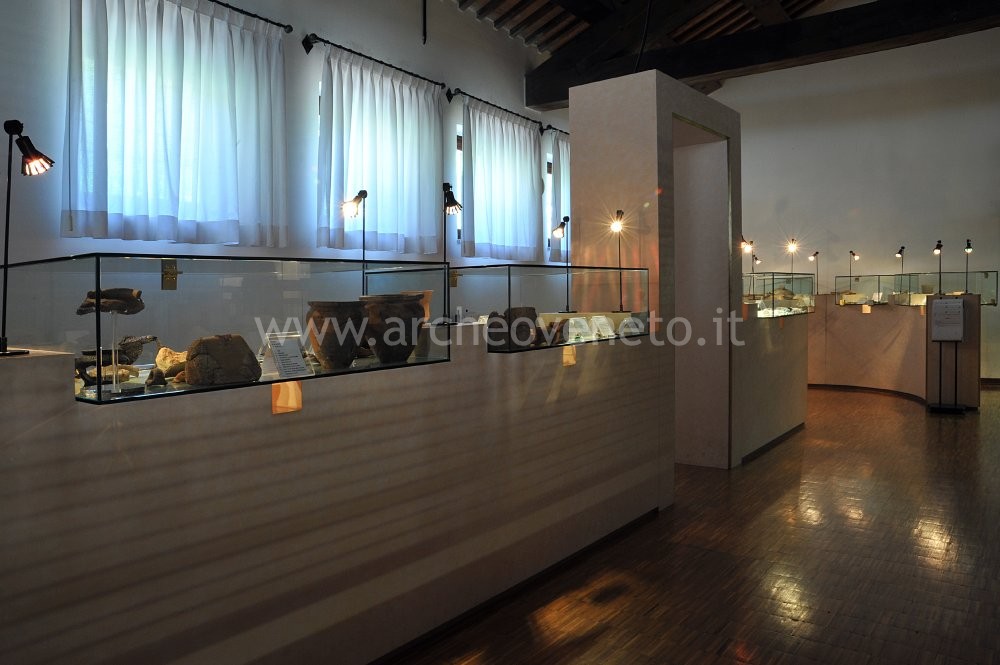 The first section is introduced by a wooden panel showing the places of origin of the items contained in the display cases. The first section is introduced by a wooden panel showing the places of origin of the items contained in the display cases.
The visit to the museum starts with an expositive exedra, made up of four display cases. The first one contains the items found in a cave on the hill of San Pietro in Sarcedo. The second display case contains the finds discovered in the sites Covolo di Lusiana and Velo di Lusiana. The materials found in the former include ceramic, stone and bone objects of the late Neolithic and the Eneolithic (late 4th-early 3rd millennium B.C.), whereas the finds discovered in the latter are mainly flint tools and just few ceramic fragments, which prove the presence of a stable settlement between the late Neolithic/Eneolithic and the early Bronze Age.
The excavation carried out in the cave Bocca Lorenza led to the discovery of pottery used for domestic purposes of the late Neolithic (proving that the site was inhabited at that time) and other materials providing evidence to the hypothesis that during Eneolithic the area was used as burial ground. The third display case contains the items found in the cave: ollas and dolia made of coarse clay, four-lobed mouth vases, round mouth bowls, globular vases, a bone putty knife and some examples of lithic industry. The materials found in the cave include also objects dating back to the Iron Age, the Roman age and the Middle Ages (displayed at the end of the section B).
The last display case of the expositive exedra mainly contains ceramic materials of the recent (13th-12th cent. B.C.) and final (11th-10th cent. B.C.) Bronze Age from the site Bostel in Rotzo and Rocchette.
The items discovered in the latter include large dolia, parts of ollas, rod-shaped cup handles of the Luco type, a bronze pin, whereas the excavation carried out in the latter led to the discovery of strap handles, fragments of bowls and a large pot of the Recent Bronze Age.
The three following display cases are aligned in a straight line. The first one contains numerous items from the site Monte Corgnon in the town of Luisiana. The displayed ceramic materials (dolia with handles and strings, ollas with strap handles, cups with horn-shaped handles, bowls and decorated biconical vases) can be referred to the recent and final bronze age, thus proving the hypothesis related to the presence of a fortified settlement in this area. The same display case and the first part of the following one contain fragments of pots of the recent (13th-12th cent. B.C.) and the final (19th cent. B.C.) Bronze Age discovered in Santorso, Valle del Castello. In the same case it is possible to see some fictile objects from Santorso, Magrè and Piovene-Castel Manduca. Moreover there is a wonderful bronze spearhead of the 11th-10th cent. B.C. found in Laghi, in the site Vanzi. The most interesting finds of this section, contained in the last display case, are those from Bostel di Rotzo. The excavation carried out in this site led to the discovery of traces of a village on the hill dating back to the second Iron Age (5th-2nd cent. B.C.), which certainly played an important role in the commercial relations in the Asiago Plateau. The items displayed include decorated ollas, cups, grey clay bowls, loom weights, decorated andirons, a horn tool handle, fragments of keys and of an iron handle.
|

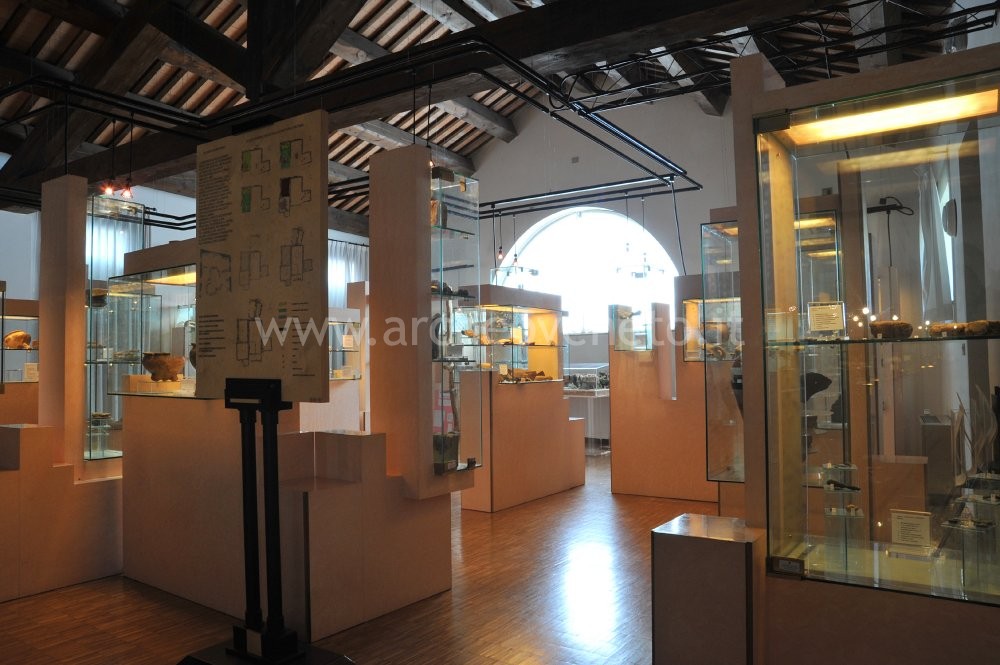 This section is fully devoted to the didactic presentation of the excavation carried out between 1981 and 1986 of a dwelling also used as workshop of the second Iron Age (5th-2nd cent. B.C.) in Santorso. In this section it is possible to see the reconstruction of the rooms composing the dwelling, which were used in different times and with different purposes. The first room (room G, storage room/still-room) is one of the most ancient ones (4th cent. B.C.). The items discovered in this room are distributed in six display cases and consist mainly of bronze and iron artefacts, a fragment of La Tène fibula, 8 specimens of aes rudes, numerous iron slag, fragments of truncated-conical and disk-shaped counterweights, an andiron, ceramic fragments and a large decorated dolium. This section is fully devoted to the didactic presentation of the excavation carried out between 1981 and 1986 of a dwelling also used as workshop of the second Iron Age (5th-2nd cent. B.C.) in Santorso. In this section it is possible to see the reconstruction of the rooms composing the dwelling, which were used in different times and with different purposes. The first room (room G, storage room/still-room) is one of the most ancient ones (4th cent. B.C.). The items discovered in this room are distributed in six display cases and consist mainly of bronze and iron artefacts, a fragment of La Tène fibula, 8 specimens of aes rudes, numerous iron slag, fragments of truncated-conical and disk-shaped counterweights, an andiron, ceramic fragments and a large decorated dolium.
Two rich display cases are devoted to the room B; one is related to its function of living area (4th-3rd cent. B.C.), whereas the second one refers to the burials found inside it (early 3rd cent. B.C.). The display case nr. 7 contains personal accessories, iron and bronze tools, querns and pestles, fragments of pottery and other materials. Two infant burials were discovered in this room: one of a newborn baby without grave goods, the other of a little girl with some objects; both burials were placed in this room, after it had lost its original function. The grave goods found are presented in the display case nr. 8; they mainly consist of bronze ornamental objects and items of clothing, glass and amber necklace beads, together with andirons and earthenware.
The room B1, possibly a still-room/kitchen, dates back to the last phases of the dwelling (late 4th-3rd cent. B.C.); the discovery of a remarkable amount of cooking and table pottery, which can be seen in the display cases 9, 10 and 11, bear witness to its function. Beside these items, there are also a trachyte pestle and metal artefacts.
The area used for metallurgical activities (room A) is presented in the display case 12, which contains a series of archaeological finds of the 4th cent. B.C. bearing witness to the function of this room: metal slag, fragments of scoriaceous discs, hammering flakes, scoriaceous microspheres, worked iron fragments, small copper and bronze ingots, and other materials. At a later stage, always in the 4th cent. B.C., the room A was divided and used as living area. The period in which the dwelling was also used as a workshop is reported in the display cases 13 and 14, where it is possible to see a small, but valuable relief moulded fictile head, certainly belonging to a large vase, as well as ornamental objects, worked bone and bronze artefacts and fragments of utilitarian pottery. On the shelves of the display case 15 there are fragments of plaster and trachyte querns found in the rooms of the dwelling.
Information on the area possibly acting as entrance hall (room C) is provided by fireplace accessories (andiron), a fragment of quern and an iron arrowhead of the mid 4th cent. B.C. (display case 16).
Display cases 17 and 18 refer to the last stage, in which the multi-room dwelling was abandoned (mid 3rd-2nd cent. B.C.).
The exhibition goes on with the three display cases referring to the room D (19, 20 and 21), a service room, where a vertical loom was possibly placed, as some fictile weights prove. In this section of the exhibition, it is also possible to see a reproduction of the loom, possibly placed in this room, and a scale model of the village to which the dwelling belonged.
The display cases 22 and 23 refer to the room F, another service room. The first one contains above all fragments of pottery, while the second one mainly metal objects. The excavation carried out in the western part of the room F led to the discovery of other two service rooms (E and H).
The following display cases are devoted to a different topic, that is the Romanization period in Santorso; they display loom weights, tiles, some coins, ceramic fragments, bronze artefacts and significant small bronzes (two statuettes representing Hercules during the fight, one standing, a man with a lorica and an offering priest).
The last display case, which was added only recently, is devoted to the numerous box rooms with tens of coins found in Santorso in the area C7.
|

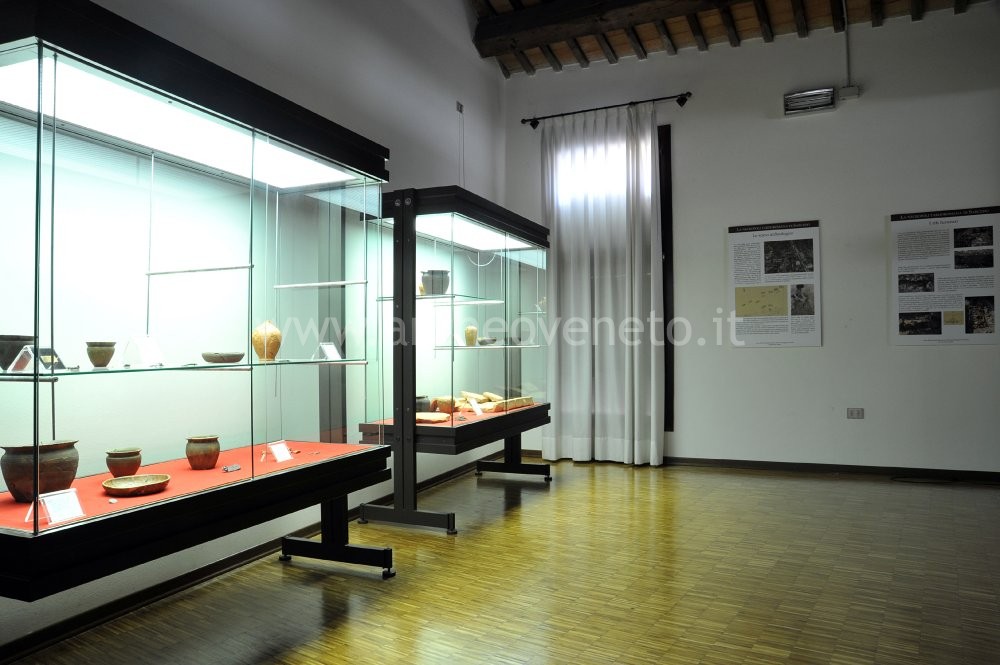 This section, which has been recently accomplished, contains two large display cases with the finds from the site Madonnetta in Sarcedo, where a late-roman necropolis was discovered (4th cent. A.D.), consisting of 22 mixed (cremation and inhumation) burials. The most interesting materials include ornamental objects and items of clothing, such as pincer-shaped fibulae, snake head-shaped armillae, rings, earrings and necklace beads. This section, which has been recently accomplished, contains two large display cases with the finds from the site Madonnetta in Sarcedo, where a late-roman necropolis was discovered (4th cent. A.D.), consisting of 22 mixed (cremation and inhumation) burials. The most interesting materials include ornamental objects and items of clothing, such as pincer-shaped fibulae, snake head-shaped armillae, rings, earrings and necklace beads.
|
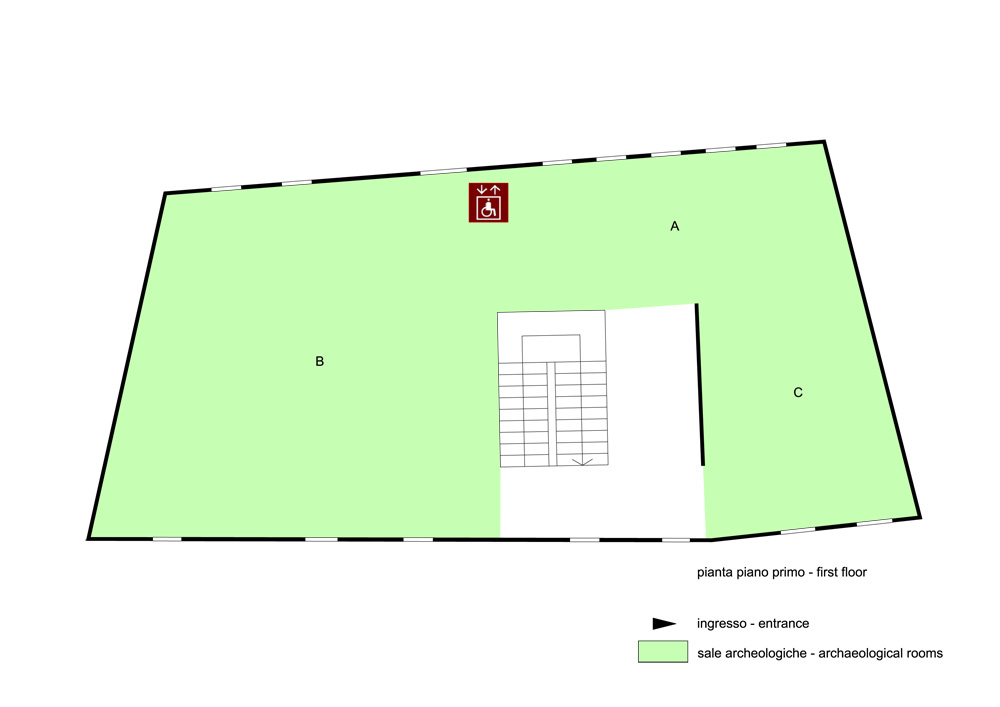
Admission: Negli orari di apertura
Solo su prenotazione
Su prenotazione
Ticket: Si
Price: 2 €
 School access School access
 Disabled access Disabled access
Opening Days
| Tipology |
When |
Specs |
| Summer/Winter |
Monday |
Upon reservation |
| Summer/Winter |
Tuesday |
Upon reservation |
| Summer/Winter |
Wednesday |
Upon reservation |
| Summer/Winter |
Thursday |
Upon reservation |
| Summer/Winter |
Friday |
Upon reservation |
| Summer/Winter |
Saturday |
Upon reservation |
| Summer/Winter |
Sunday |
15.00 – 18.00 |
Recommended tour time (minutes): 60
 Guide a stampa Guide a stampa
Brochure
Catalogo
Italian
 Information boards Information boards
Italian
 Mobile cards Mobile cards
Italian
 Captions under exhibits Captions under exhibits
Italian
 PC learning points PC learning points
Italian
 Guided Tours Guided Tours
 Educational activities Educational activities
 Educational workshops Educational workshops
 Library and documentation centre Library and documentation centre
 Other activities Other activities
| Museo Archeologico dell’Alto Vicentino. Catalogo 1997, a cura di Carollo E., Giovanetti E., Panozzo N., Schio . |
| Panozzo N. 2001, Le cose raccontano Santorso, mostra archeologica didattica, Fara Vicentina. |
| Musei e raccolte archeologiche del Veneto 2004, a cura di Di Mauro A., Dosson di Casier, pp. 141. |
| Bonetto J. 2009, Veneto (Archeologia delle Regioni d’Italia), Roma, pp. 378-379. |
|

